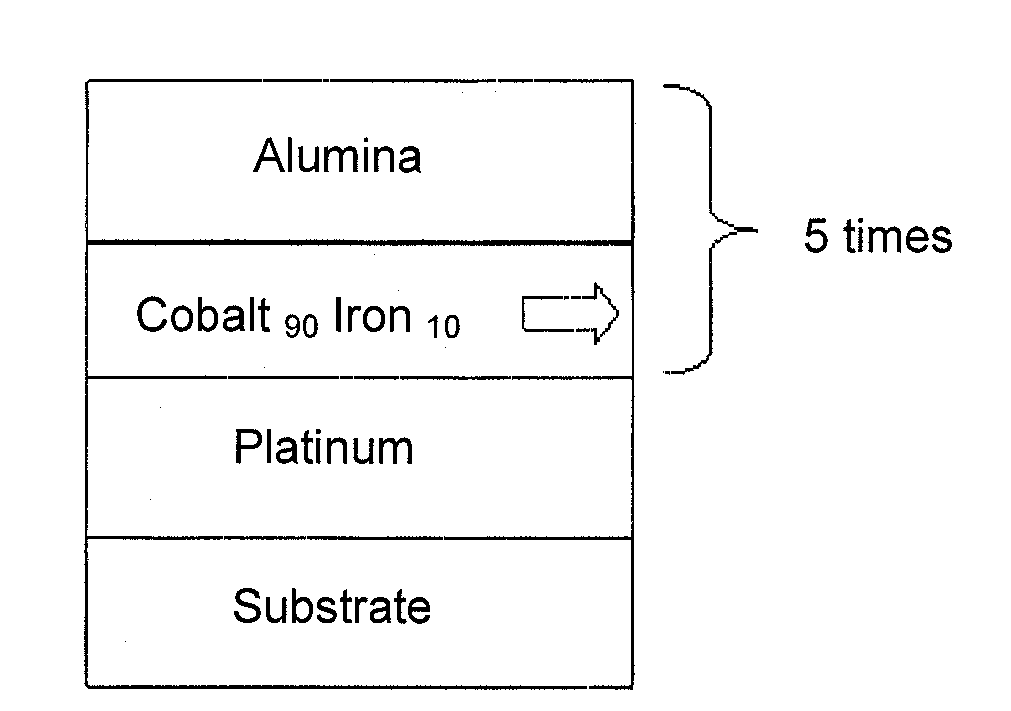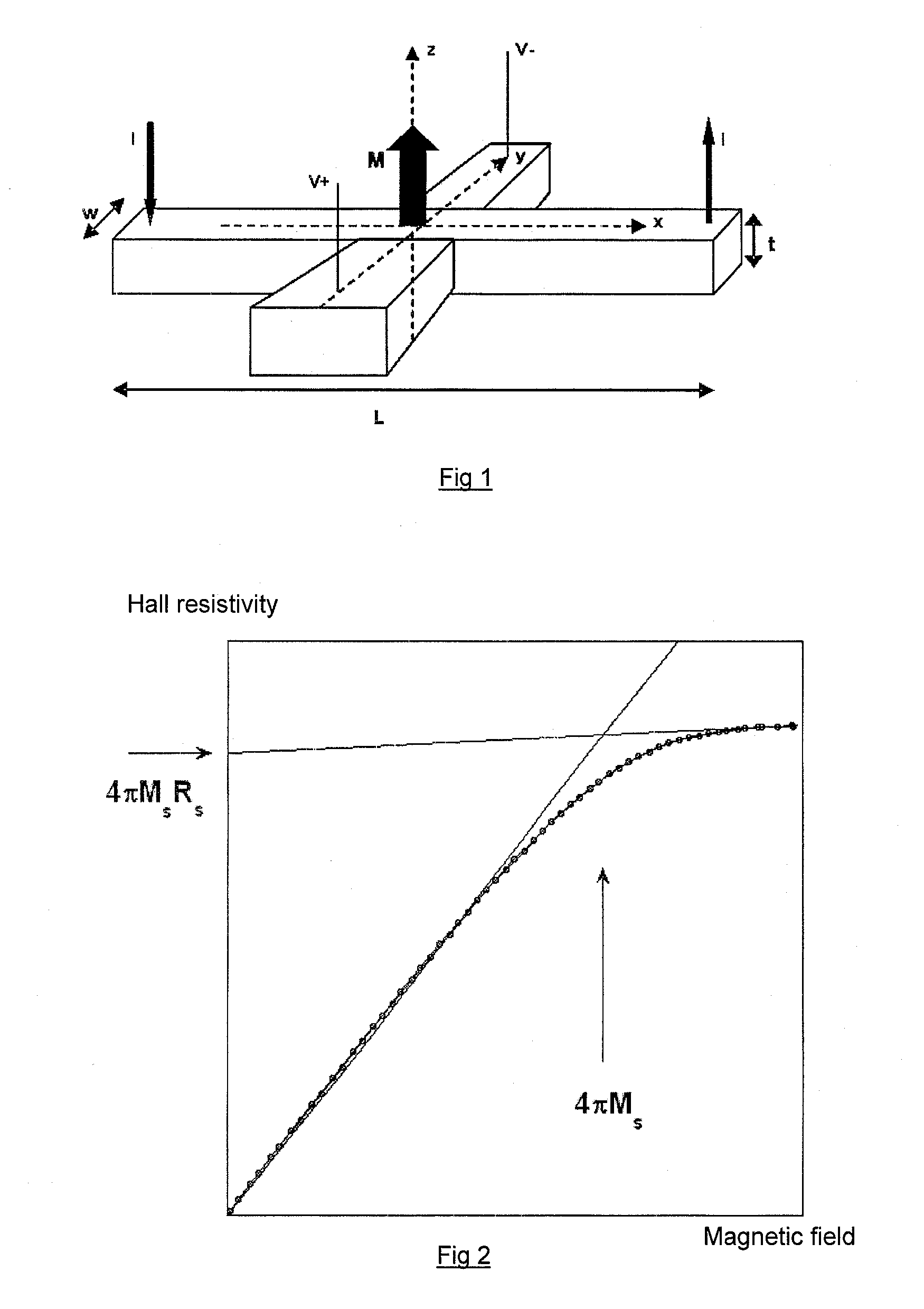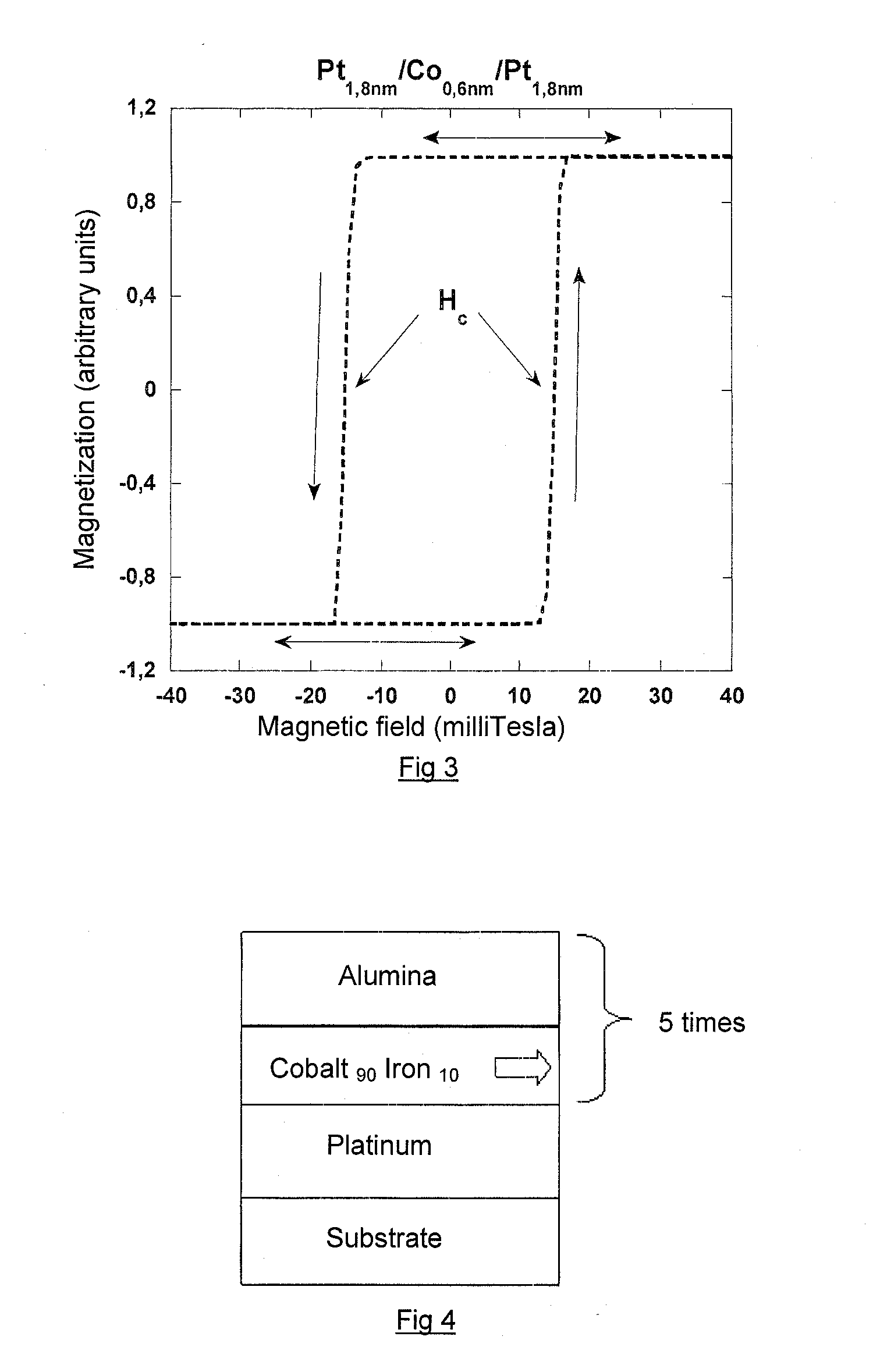Magnetic multilayer device, method for producing such a device, magnetic field sensor, magnetic memory and logic gate using such a device
a multi-layer device and multi-layer technology, applied in the field of magnetic materials, can solve the problems of low longitudinal resistivity of materials, increased difficulty in deliberately changing the magnetization direction, and very rapid decrease, and achieve high longitudinal resistivity, high extraordinary hall coefficient, and high perpendicular anisotropy
- Summary
- Abstract
- Description
- Claims
- Application Information
AI Technical Summary
Benefits of technology
Problems solved by technology
Method used
Image
Examples
first embodiment
[0107]FIG. 4 is a schematic view of the invention. In this Figure (and subsequent FIGS. 6, 8, and 11), the direction of the arrows indicates the magnetization direction (in the absence of an applied magnetic field) of the magnetic layers (horizontal arrow for planar magnetization, vertical arrow for perpendicular magnetization).
[0108]Immediately after the substrate there is a layer of growth initiating material, such as platinum for example. It can be replaced by another material or by a combination of other materials regarded as suitable for initiating satisfactory growth of thin metallic layers, especially those that result in extremely slight surface roughness. Examples include titanium nitride, copper nitride, ruthenium, tantalum, iridium-manganese alloys, platinum-manganese, nickel-iron-chrome, etc. It is also possible not to use this initial layer if it is established that quality of growth of the magnetic layer on the substrate is satisfactory.
[0109]This is followed by the fi...
second embodiment
[0124]FIG. 6 is a schematic view of the invention. FIG. 7 shows variation in Hall resistance as a function of magnetic field for a structure of the Pt 1.0 nm / Co 0.6 nm / Al2O3 2.0 nm / (CoFe 0.6 nm / Al2O3 2.0 nm)5 type, i.e. a (Co / Al2O3) bilayer deposited on a platinum growth layer having a thickness of 1 nm and topped by five (CoFe / Al2O3) bilayers.
[0125]As in the previous case, the longitudinal resistivity of this stack is also of the order of 1000 μΩcm. The Hall resistance is smaller than in the previous case (of the order of 4Ω at saturation rather than 8Ω), firstly because of the larger number of stack repetitions (6 in total rather than 5) and secondly the negative effect of the thicker initial platinum layer (1.0 nm rather than 0.3 nm) which derives a fraction of the current that flows through the structure.
[0126]In contrast, this slightly thicker platinum layer significantly enhances perpendicular magnetic anisotropy properties. In fact, the perpendicular anisotropy field is only ...
third embodiment
[0129]This case is shown in the invention which is schematically illustrated in FIG. 8 with a stack identical to that shown in FIG. 6, but for which the oxidation conditions were slightly modified (oxygen pressure slightly reduced during plasma oxidation of aluminum layer), consequently stabilizing the magnetization direction of the layers perpendicular to the plane of said layers, even in the absence of an applied magnetic field. This type of structure is therefore ideally suitable for producing magnetic memories or magnetic logic gates.
[0130]As shown in FIG. 9, in this case one obtains two stable states in a zero magnetic field, i.e. a Hall resistance of + / −3.5Ω, depending whether magnetic fields are positive or negative. Hall resistance inversion occurs with extremely weak magnetic fields of the order of 0.3 mT in the present case.
[0131]The reader is again reminded that this parameter (coercive field, as defined in relation to FIG. 3) can also be adjusted either by modifying the ...
PUM
| Property | Measurement | Unit |
|---|---|---|
| thickness | aaaaa | aaaaa |
| thickness | aaaaa | aaaaa |
| thickness | aaaaa | aaaaa |
Abstract
Description
Claims
Application Information
 Login to View More
Login to View More - R&D
- Intellectual Property
- Life Sciences
- Materials
- Tech Scout
- Unparalleled Data Quality
- Higher Quality Content
- 60% Fewer Hallucinations
Browse by: Latest US Patents, China's latest patents, Technical Efficacy Thesaurus, Application Domain, Technology Topic, Popular Technical Reports.
© 2025 PatSnap. All rights reserved.Legal|Privacy policy|Modern Slavery Act Transparency Statement|Sitemap|About US| Contact US: help@patsnap.com



